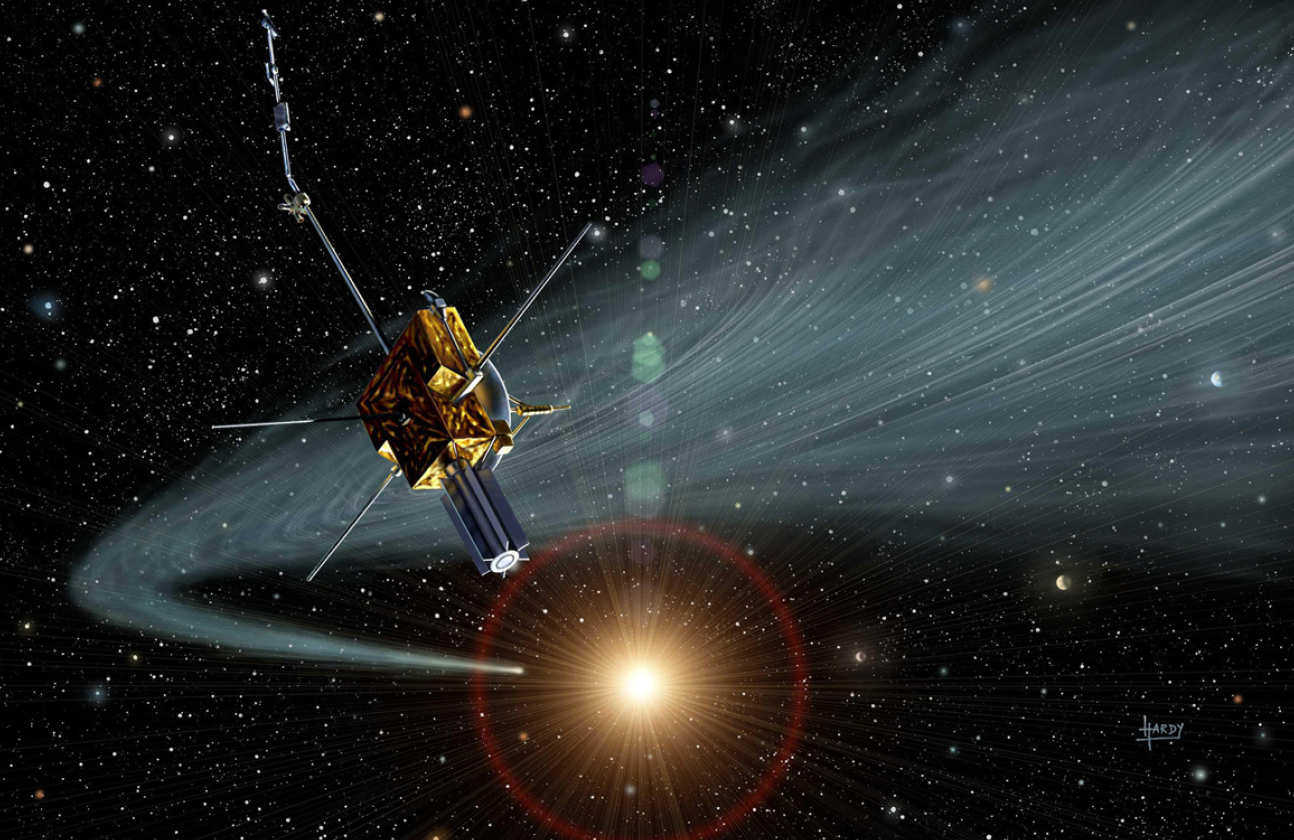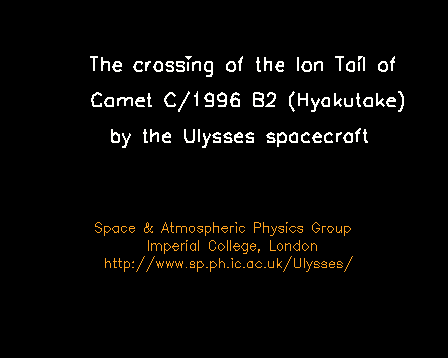Ulysses's Hyakutake Encounter
How was the tail crossing found?
 In 1998, Pete Riley (then of the Los Alamos National Laboratory) and colleagues reported their discovery of a very strange event in the data returned from the SWOOPS instrument aboard Ulysses. They had found that on May 1, 1996, the number of protons seen at Ulysses dropped dramatically for several hours. This was rather puzzling to say the least. Other instruments aboard the spacecraft had also detected the event at Ulysses.
In 1998, Pete Riley (then of the Los Alamos National Laboratory) and colleagues reported their discovery of a very strange event in the data returned from the SWOOPS instrument aboard Ulysses. They had found that on May 1, 1996, the number of protons seen at Ulysses dropped dramatically for several hours. This was rather puzzling to say the least. Other instruments aboard the spacecraft had also detected the event at Ulysses.
One of those instruments was the magnetometer, which measures the strength and direction of the magnetic field of the solar wind as it is carried away from the Sun past the spacecraft. Looking at the magnetometer data from May 1, Imperial College and Queen Mary and Westfield College scientists noticed that they seemed reminiscent of a 'wake', and were broadly symmetrical. Further analysis revealed that the magnetic field direction remained broadly constant for several minutes at a time during this period. Looking at the event as a whole, they came to the conclusion that the field lines were hairpin-shaped. This is exactly what is expected in comets' ion tails.
Working independently of the magnetometer team, the Ulysses SWICS team, led by Prof. George Gloeckler of the University of Maryland discovered signatures of cometary ions in the data returned from their instrument.
Ulysses's Hyakutake Encounter
- How was the comet identified?
- An Animation of the Tail
- What has the tail crossing told us?
- What next for cometary missions?
Once the magnetometer team were convinced that Ulysses had encountered a comet tail, its source had to be found. The most obvious place to look was close to the spacecraft. However, no known comets were anywhere near Ulysses on May 1. So the search had to be widened.
For Ulysses to cross a comet's tail, a comet had to have passed between the Sun and the spacecraft (because the solar wind flows almost directly away from the Sun). However, Ulysses was very far from the Sun. Even travelling at hundreds of kilometres per second, the solar wind carrying a comet tail could take days to reach the spacecraft. In that time, the source comet had ample time to move away from the Sun-comet line.
When the magnetometer team looked at the location of Comet Hyakutake, they found that it had crossed the Sun-Ulysses line around April 23, 1996. Had this happened at the correct time? Pete Riley and colleagues had reported that the solar wind speed during that tail crossing had been around 750 kilometres per second. If the tail had been travelling for that speed all the way from the Hyakutake's head to Ulysses, it would have taken around 8 days to make the journey (the exact travel time would however depend on how fast the ions in the tail were accelerated up to the solar wind speed).
This amazing chance aligment at the right time for the spacecraft to cross the comet's tail when the strange solar wind features were seen was a strong sign that Ulysses had actually crossed the tail of Hyakutake.
To double check that it really was Hyakutake's tail, the team used the magnetometer data to determine which way the ion tail was pointing. It turned out to be parallel to the orbital plane of Hyakutake, exactly as expected. They also checked that the tail was the expected size. They had estimates of the amount of gas being given off by the comet on April 23, and were thus able to estimate how big the tail should have been. The tail diameter of at least 7 million km fitted in their range of estimates. The tail had been identified.

The date is shown at lower left. The blue horizontal plane is the ecliptic - the plane in which the Earth's orbit lies. Earth's orbit can be seen lying in that plane, and the Earth's position is shown by a white dot. Hyakutake's orbit is shown by the red line (darker where below the ecliptic). Also shown in the position and orbit of Ulysses (orange above the ecliptic; red below).
As the comet approaches perihelion, its ion tail grows in length (white above the ecliptic, grey below), and remains parallel to the plane of Hyakutake's orbit. Around closest approach to the Earth in late March, the tail is curved around the Earth, explaining why many people saw a very long tail at that time.
In mid-April, the comet entered the fast solar wind which was flowing from the Sun's poles at the time. This can be seen as a kink in the comet's tail, which eventually develops into a break, when the part of the tail in the fast wind overtakes the slower part of the tail.
An amazing sequence of events then happens. Hyakutake crosses the orbital plane of Ulysses on April 23, and the part of the tail that will be crossed by Ulysses starts its journey to the spacecraft. In the 8 days it takes that part of the tail to reach Ulysses's orbit, the spacecraft approaches Hyakutake's orbital plane. When Ulysses crosses that plane, the tail arrives, and the spacecraft crosses it. The chances of such a fortunate sequence of events taking place are thought to be very slim.
The most remarkable immediate result is the amazing tail length of 3.8 AU (570 million km / 360 million miles). It beats the previous claimed record of 2.2 AU (330 million km / 206 million miles), held by the Great March Comet of 1843. Although we can't say that Hyakutake's tail is the longest comet tail, it is the longest that anyone has been able to measure!
This event has provided unique information about the conditions within cometary ion tails when very far downstream of the nucleus. All other spacecraft encounters with comets have taken place near the comet's head. Hyakutake is the most productive comet ever to have been encountered by a spacecraft.
A complete analysis of the data will take several years to complete. Finding and identifying the tail crossing is only the beginning of the work. When the data from all the instruments that detected the tail are compared, we're sure that we'll learn a lot about what happens in cometary ion tails.
There are several cometary missions in progress or in preparation. Deep Space 1 may have its mission extended to allow it to visit a comet. Stardust is on its way to comet Wild-2, to gather dust samples and to return them to Earth. The Contour mission will aim to visit several cometary nuclei.
The most ambitious mission is the European Space Agency's Rosetta, which will be launched in 2003 to eventually rendezvous and enter orbit about the nucleus of Comet Wirtanen when far from the Sun. The craft will then accompany the comet as it approaches the Sun, observing its development, and will drop a lander onto its surface.
Of course, there is always the chance that a spacecraft will have an unexpected encounter with a comet!
The identification of Hyakutake as the source comet was made using XEphem astronomy software for Unix.